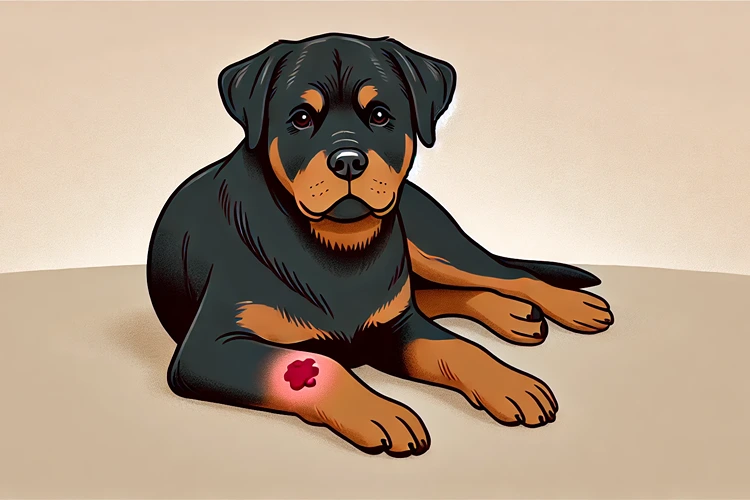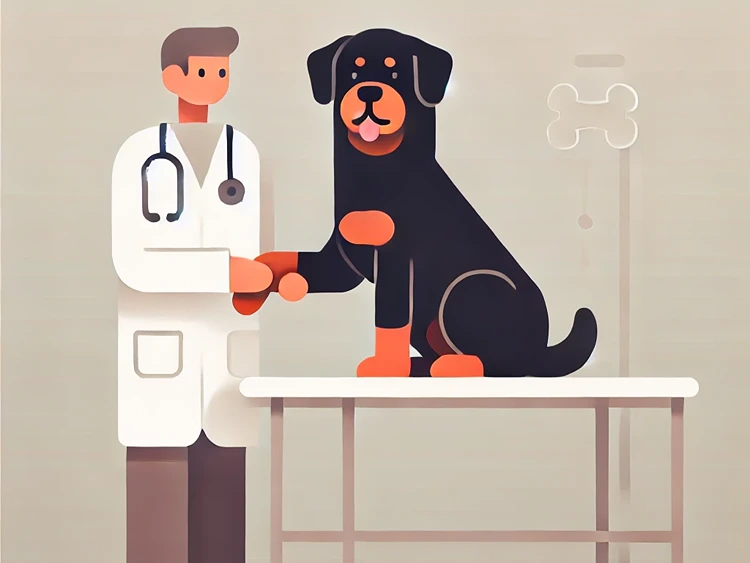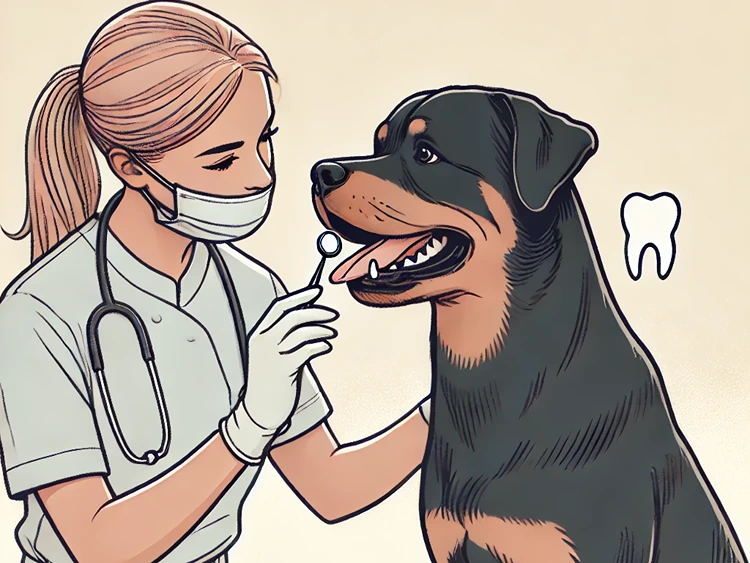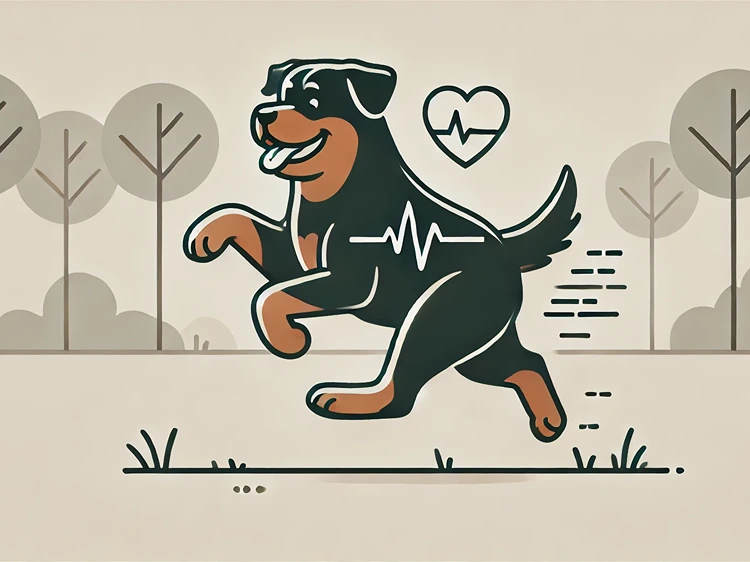If you’re a Rottweiler owner, you know just how important it is to keep your furry friend happy and healthy. But sometimes, despite our best efforts, issues like hot spots can pop up, leaving your Rottweiler feeling uncomfortable. Hot spots are painful, inflamed patches of skin that can quickly become a bigger problem if left untreated. Recognizing and treating these skin issues promptly can save your Rottie a lot of discomfort.
What Are Hot Spots?
Hot spots, also known as “acute moist dermatitis,” are red, irritated patches on a dog’s skin. These areas can be warm to the touch and are often moist due to the dog licking or scratching the area excessively. While hot spots can appear on any dog, Rottweilers are more prone to skin conditions due to their thick coats, which can trap moisture and bacteria against the skin.
Hot spots can develop quickly, sometimes within hours, and are typically the result of an underlying issue such as allergies, flea bites, or even stress. If not addressed early, they can become infected, leading to further complications. Keeping an eye on your Rottweiler’s skin and coat is crucial in catching these spots before they escalate.
Paw-some Tip:
If your Rottweiler has been scratching or licking one area more than usual, it’s worth taking a closer look. Hot spots can spread fast, so early detection is key to preventing serious discomfort.
How to Identify Hot Spots on Your Rottweiler
Recognizing a hot spot on your Rottweiler might seem tricky, but there are some clear signs that can help you identify the problem. Here’s what to look for:
- Red, inflamed patches of skin: Hot spots are usually very noticeable due to their bright red color and irritated appearance.
- Moist or oozing skin: The affected area will often be wet or sticky because of your dog’s constant licking or biting.
- Hair loss around the area: You might notice a bald spot around the hot spot, as the fur may fall out due to the skin irritation.
- Foul odor: If the hot spot has become infected, it might start to smell bad.
If you notice any of these signs, it’s time to take action. Hot spots can quickly worsen, especially if your dog keeps licking the area, so it’s important to intervene early.
What Causes Hot Spots on Rottweilers?
Understanding the cause of hot spots can help you prevent them in the future. Some common causes include:
- Allergies: Rottweilers, like many dogs, can have allergies to food, pollen, or fleas. These allergies often cause itching, which can lead to excessive scratching and the formation of hot spots.
- Poor grooming: If your Rottweiler’s coat isn’t groomed regularly, moisture can get trapped under the fur, creating an ideal environment for bacteria to grow and irritate the skin.
- Flea infestations: Fleas are notorious for causing itchy, irritated skin. If your Rottie has fleas, the constant scratching can result in hot spots.
- Stress or boredom: Dogs can develop hot spots as a result of stress or boredom, as they may chew on their skin out of frustration.
Rottie Stats:
Did you know that nearly 20% of all dog skin problems are related to flea allergies? Regular flea prevention can reduce the chances of your Rottweiler developing hot spots due to these pesky parasites.
Common Causes of Hot Spots in Rottweilers and Prevention Methods
| Cause | Prevention Method |
|---|---|
| Fleas and Ticks | Regular use of flea and tick preventatives, frequent coat checks |
| Food Allergies | Switch to hypoallergenic food, consult vet for elimination diet |
| Moisture in the Coat | Ensure coat is thoroughly dried after baths, swims, or rain exposure |
| Stress or Boredom | Provide mental stimulation, regular exercise, and attention |
| Poor Grooming | Brush regularly, ensure fur is clean and free from mats |
How to Treat Hot Spots on Your Rottweiler
Treating hot spots on your Rottweiler as soon as they appear is essential to prevent infection and further discomfort. Here’s how you can help your pup heal:
Step 1: Trim the Fur Around the Hot Spot
The first step in treating a hot spot is to gently trim the fur around the affected area. This will help expose the skin and allow you to clean the area properly. Be careful not to cut too close to the skin, as it may already be sore.
Step 2: Clean the Area
Use a mild antiseptic solution to clean the hot spot. Avoid using harsh chemicals, as they can irritate your dog’s skin further. You can use a solution like diluted betadine or an antiseptic spray recommended by your vet.
Paw-some Tip:
Always have some mild antiseptic wipes or sprays on hand for emergencies. Cleaning the hot spot early on can prevent it from getting worse.
Step 3: Keep Your Rottweiler From Licking or Scratching
Preventing your Rottweiler from licking or scratching the hot spot is crucial. You can use an Elizabethan collar (the dreaded “cone of shame”) or a soft recovery collar to stop them from reaching the area.
Step 4: Apply a Topical Treatment
Your vet may recommend a topical treatment such as a medicated cream or spray. These treatments often contain antibiotics or anti-inflammatory ingredients to help soothe the skin and fight infection. Be sure to follow your vet’s instructions carefully when applying these products.
Step 5: Consult Your Veterinarian
If the hot spot doesn’t start to heal within a few days or seems to be getting worse, it’s time to consult your vet. They may prescribe oral antibiotics or other medications to help clear up the infection.
How to Prevent Hot Spots on Your Rottweiler
Now that you know how to recognize and treat hot spots, let’s focus on how to prevent them from happening in the first place. While it’s not always possible to avoid hot spots entirely, there are several steps you can take to reduce the risk. By keeping your Rottweiler’s skin healthy and minimizing the factors that lead to hot spots, you’ll make a big difference in your dog’s overall well-being.
Regular Grooming
One of the most important ways to prevent hot spots is by grooming your Rottweiler regularly. Their thick coats can trap moisture, dirt, and bacteria, leading to skin irritation. Here’s what you can do:
- Brush your Rottie’s coat frequently: Regular brushing removes dead hair, dirt, and debris that can irritate the skin.
- Keep the coat dry: After baths, swims, or walks in the rain, make sure your dog’s coat is completely dry. Moisture trapped in the coat can lead to bacterial growth, which may cause hot spots.
- Regular bathing: Use a dog-friendly shampoo to keep their skin clean and healthy, but avoid over-bathing, as it can strip the skin of essential oils.
By maintaining a consistent grooming routine, you’ll be able to spot any skin issues early on and take action before they develop into full-blown hot spots.
Flea and Tick Prevention
Fleas and ticks are common culprits behind hot spots. These pests cause intense itching, leading your Rottweiler to scratch and bite at their skin, which can result in irritation and hot spots. Using flea and tick preventatives year-round is crucial, especially if you live in an area where these pests are prevalent.
Talk to your vet about the best flea and tick prevention options for your dog. There are many choices, from oral medications to topical treatments and flea collars. Find what works best for your Rottie and stick to a regular schedule to keep these pests away.
Paw-some Tip:
Check your Rottweiler’s coat frequently for signs of fleas or ticks, especially during warmer months. Early detection can prevent the itching that leads to hot spots.
Managing Allergies in Rottweilers
Allergies are another common cause of hot spots. Rottweilers can be allergic to various things, including certain foods, pollen, or even household products. Identifying and managing these allergies can significantly reduce the risk of hot spots.
Food Allergies
Some dogs have food allergies that cause skin irritation, which can lead to hot spots. Common culprits include beef, chicken, dairy, and grains. If you suspect your Rottweiler has a food allergy, consult your vet. They may recommend an elimination diet to identify the specific ingredient causing the problem.
Once you’ve identified the allergen, switch to a dog food that doesn’t contain it. Many hypoallergenic dog foods are available that cater to dogs with food sensitivities. Additionally, adding omega-3 fatty acids to your dog’s diet can help promote healthy skin and reduce inflammation.
Environmental Allergies
Rottweilers can also be allergic to environmental factors like pollen, dust mites, or mold. These allergens can cause itchy skin, which might lead to hot spots if your dog scratches excessively. If you think your dog has environmental allergies, your vet may suggest allergy testing to pinpoint the cause.
In the meantime, you can help manage environmental allergies by:
- Wiping your dog’s paws and belly after walks to remove pollen.
- Using air purifiers and regularly cleaning your home to reduce dust and mold.
- Discussing allergy medication or immunotherapy options with your vet.
Providing Mental Stimulation and Physical Activity
Believe it or not, boredom and stress can also lead to hot spots in Rottweilers. Dogs that are bored or anxious may start to chew or lick their skin excessively, causing irritation and, eventually, hot spots. Keeping your Rottweiler mentally and physically engaged is key to preventing this.
Mental Stimulation
Rottweilers are intelligent dogs that thrive on mental challenges. Boredom can lead to destructive behaviors like excessive licking or chewing. To keep your dog’s mind busy, consider:
- Using puzzle toys that dispense treats or kibble.
- Teaching your Rottie new tricks or commands.
- Playing interactive games like fetch or tug-of-war.
Regular mental stimulation can help reduce stress and prevent behaviors that lead to hot spots.
Regular Exercise
Along with mental engagement, Rottweilers need plenty of physical exercise to stay healthy. A tired dog is less likely to develop bad habits like excessive licking. Make sure your Rottie gets daily exercise in the form of walks, runs, or playtime in the yard.
Rottie Stats:
A Rottweiler that gets enough exercise is 40% less likely to develop stress-related behaviors like excessive licking or chewing, which can lead to hot spots.
When to See a Veterinarian
While many hot spots can be treated at home, there are times when it’s best to consult a veterinarian. If your Rottweiler’s hot spot doesn’t improve after a few days of treatment, or if it seems to be getting worse, it’s time to seek professional help.
Your vet might prescribe stronger medications, such as antibiotics or anti-inflammatory drugs, to help clear up the infection. In some cases, the vet may also want to investigate the underlying cause, such as allergies or an infection, to prevent future hot spots.
FAQs
Wrapping Up
Keeping your Rottweiler’s skin healthy and free from hot spots is all about early detection and proactive care. Hot spots can quickly become painful and problematic, but with proper grooming, managing allergies, and providing enough mental and physical stimulation, you can reduce the chances of these skin irritations occurring. Regularly checking your Rottweiler’s coat for signs of irritation, fleas, or moisture can prevent hot spots before they start. If you do spot a hot spot, prompt treatment and consulting with your vet when necessary will ensure your dog gets back to feeling their best quickly. Taking these steps will keep your Rottweiler happy, healthy, and comfortable for years to come.
Remember, hot spots are a common issue but can be easily managed with the right care. Stay vigilant about your dog’s skin health, and don’t hesitate to act if you notice anything unusual. By following the tips outlined in this article, you’ll not only treat hot spots effectively but also prevent them from returning.




